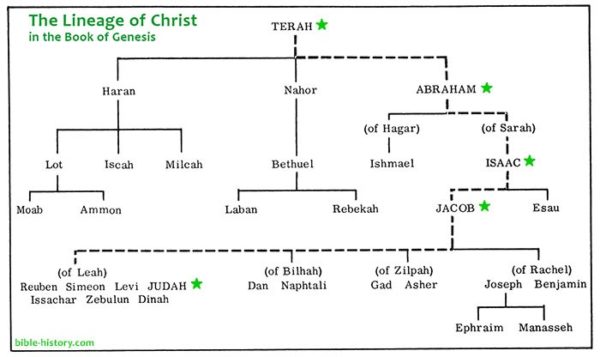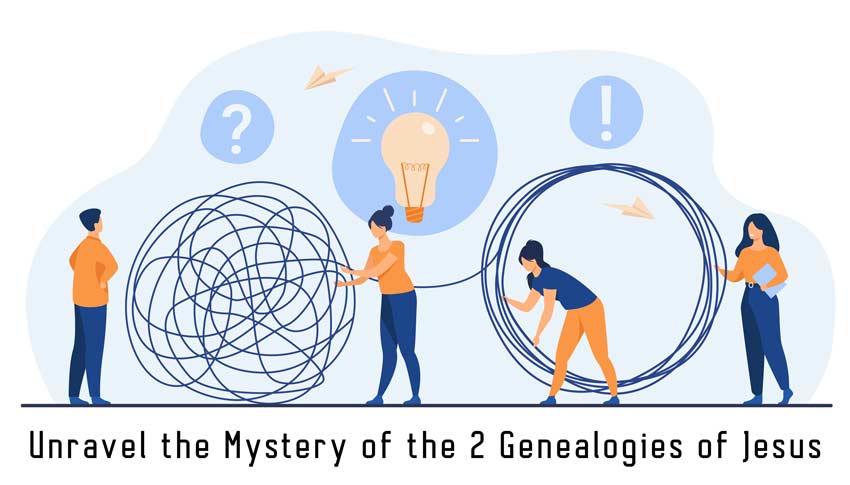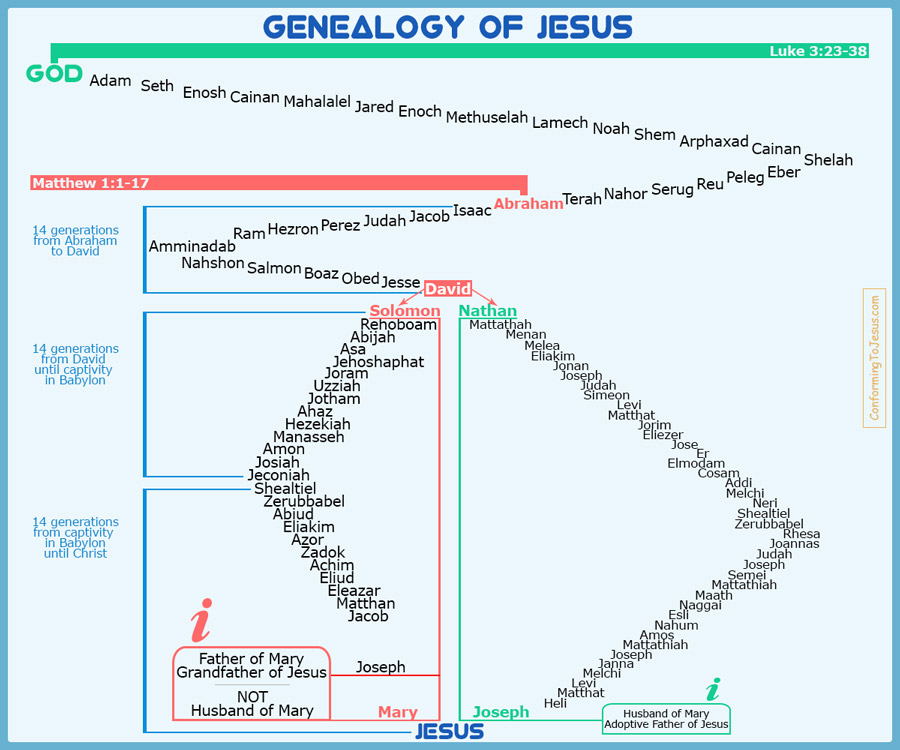Family trees have also been used as a teaching device. Presenting information in a family tree form helps students understand relationships, keep track of individuals and events. In the Bible, a family tree appears in the first book of Chronicles, where names of ancestors are listed down 30 generations. By following these leaves backward in time, one finds that all the people on earth today could be related 31 generations ago—to an individual named Noah.
The Bible tells us that Adam and Eve had two sons, Cain and Abel. Cain murdered Abel, so God sent him away to live on his own.
After thousands of years, there were many people living on Earth. But since all people have different parents, there were also many different groups of people living close together or far apart from one another.
When families are related to each other through their ancestors, they are said to be related by “bloodlines” or “bloodlines” (also called “bloodlines”).

Family Trees Of The Bible
The New Testament provides two accounts of the Genealogy of Jesus, one in the Gospel of Matthew (Matthew 1:1-17) and another in the Gospel of Luke (Luke 3:23-38).
The Family Tree of Jesus in the Gospel of Matthew starts with Abraham, and mentions that there are 14 generations from Abraham to David, 14 from David to the exile, and 14 from the exile to Jesus. The lineage of Jesus in the Gospel of Luke gives the same lineage, but it includes His ancestors all the way to Adam.

In the Old Testament, it was prophesied that the Savior, namely the Messiah, would come from the Tribe of Judah and from the line of King David.
Messiah from the Tribe of Judah – Genesis 49:10 – “The scepter (symbol of kingship) shall not depart from Judah, nor a lawgiver from between his feet, until Shiloh comes; and to Him shall be the obedience of the people.”
Messiah from the line of King David – Jeremiah 23:5-6 – “Behold, the days are coming,” says the Lord, “That I will raise to David a Branch of Righteousness; a King shall reign and prosper, and execute judgment and righteousness in the earth. In His days Judah will be saved, and Israel will dwell safely; now this is His name by which He will be called: THE LORD OUR RIGHTEOUSNESS.”
Messiah from the line of King David – Isaiah 11:1 – “There shall come forth a rod (= shoot) from the stem (= trunk) of Jesse (= David’s father), and a Branch shall grow (= be fruitful) out of his roots.”
Both Gospels of Matthew and Luke provide genealogies of Jesus that confirm He was a descendent of King David and therefore, the legitimate promised Messiah. But they differ in an important point: Matthew follows the line of David’s son Solomon, while Luke follows the line of Nathan, who is another son of David. This results in two distinct genealogies and some argue that either Matthew or Luke got it wrong.
In Matthew’s account, the lineage of Jesus goes back to King David through his son Solomon and in Luke’s account through his son Nathan. Matthew has twenty-seven generations from David to Joseph, whereas Luke has forty-two. The two accounts also contradict each other on who Joseph’s father was: Matthew says his father was Jacob, while Luke says he was Heli. They are two completely different genealogies and they contradict each other.
But that is not the only difference.
If we read Matthew 1:1-17 and Luke 3:23-38 carefully, we can clearly see that both Gospels present the Genealogy of Joseph, who is the adoptive father of Jesus, not His biological father.
The first question that arises is: if Joseph is not the biological father of Jesus, why do the writers of both Gospels provide his bloodline, instead of providing the bloodline of Mary, who is the biological mother of Jesus and, therefore, the only one biologically related to Him?
Furthermore, since both bloodlines are presented as the family trees of Joseph, one might come to the conclusion that he had to be somehow involved in the conception of Jesus, and this in turn would deny the virgin birth of Christ.
This would make Joseph the biological father of Jesus, instead of His adoptive father, and Mary not a virgin at the time of conception. Right? And if it were so, since Joseph and Mary were only engaged and not yet legally married, they would have been found in fornication, according to God’s Law, and both would have been stoned to death as transgressors.

Similarly, since both genealogies are presented as the family trees of Joseph, who was the adoptive father of Jesus, not His biological father, you cannot actually establish that Christ is a direct descendant by blood of King David, or that He is a descendant from the Tribe of Judah. In order for Jesus to be accepted as the promised Messiah by the people of Israel, He would have been expected to be from the Tribe of Judah and a descendant of King David.
Matthew begins by calling Jesus the son of David, clearly indicating His kingly origin, but fails (…based on all current translations of the Bible) to demonstrate that Jesus was a biological descendant of King David. If we cannot prove this, we cannot prove that Jesus is in fact the long awaited promised Messiah and this would be a HUGE PROBLEM!
Bible scholars at various times have come up with all kinds of probable explanations; the only problem is that each explanation is not supported by what we find in the text nor by any of the original manuscripts in the Greek language. They are all desperate attempts to find a solution where the text in fact provides none.
One of the earliest explanations, given by the church historian Eusebius (265-340 A.D.), is that Joseph’s father was married to his brother’s widow in a Levirate marriage, a Jewish practice according to which, if a married man died childless, his brother was expected to marry the widow, and their eldest son would be legally considered to be the son of the deceased first husband. So, according to this theory, one genealogy would be for Joseph’s uncle and one genealogy would be for his biological father.
According to Eusebius’ supposition, Heli and Jacob were half-brothers, Heli died without an heir, and so his brother Jacob married Heli’s widow, who then gave birth to Joseph. So, based on this elaborate story, Joseph was the “son of Heli” legally but the “son of Jacob” biologically.
Consequently, the Gospels of Matthew and Luke are both giving Joseph’s genealogy, but Luke follows the legal bloodline, while Matthew follows the biological bloodline. But this interpretation is totally made-up! The Greek text does not substantiate this theory.
Another explanation is that Matthew’s genealogy is the royal bloodline of Jesus and Luke’s genealogy is the natural bloodline of Jesus, but there is nothing in the text that would indicate that. This interpretation is totally made-up, as well! Again, these are all desperate attempts to find a solution where in fact the text provides none.
Another creative explanation, that Bible scholars have come up with, is that the Gospel of Luke is recording Mary’s lineage while the Gospel of Matthew is recording Joseph’s. They say that, since there was no Greek word for “son-in-law,” Joseph was called the “son of Heli” by marriage to Mary; according to this theory, Mary would be the daughter of Heli.
This opinion is held by some conservative Christian Bible scholars, who find it unimaginable that the bloodline of a man would be traced through his mother’s side of the family in a patriarchal society. And when it was, the husband would be named instead of her, and she would remain invisible.

Unfortunately, this explanation is also totally made-up and in direct contrast to the Bible itself! The Word of God had already plainly stated that the Messiah would have come from “the woman” back in Genesis 3:15 – “I will put enmity between you (serpent) and the woman, and between your seed and her Seed; He shall bruise your head, and you shall bruise His heel”.
This was never a secret, it was common knowledge since the fall of mankind, so why would the Bible hide it now? The text does not say anywhere that Mary was Heli’s daughter, because she was not and to say that Joseph was called the “son of Heli” by marriage to Mary is pure invention and a desperate way to find a solution where… again, the text clearly provides none.
Additionally, although this interpretation is the only one that would prove that Jesus is a descendant of David, it still wouldn’t make Him eligible to be the Messiah, as the Gospel of Luke traces the genealogy of Jesus to King David through his son Nathan, but the Messiah had to be a descendant of David through his son Solomon, according to 2 Samuel 7:12-14 – “When your (= David) days are fulfilled and you rest with your fathers, I will set up your seed after you, who will come from your body, and I will establish His kingdom. He shall build a house for My name (= Solomon built the Temple, not Nathan), and I will establish the throne of his kingdom forever. I will be his Father, and he shall be My son.”
This explanation just does not make any sense, either!
So, how can we explain the differences in the genealogies of Jesus?
The answer can be found only if someone takes the time and makes the effort of doing some serious research, goes beyond all available translations and looks at some of the original texts of the Gospels with the determination of finding the answer. When this answer is found, everything falls in place and makes perfect sense, as it should, as the Word of God is perfect.
This Chart of the Genealogy of Jesus is based on our research into this age-long problem and shows our exciting findings.
THE GENEALOGY OF JESUS CHART
Family Tree Of Adam And Eve
How family trees work
Are you new to genealogy, and wondering how do family trees work? Don’t feel silly for asking- it’s actually a great question, and there are many important things to understand about family trees before beginning your research. A family tree is like a map that connects a person to their ancestors. It begins with yourself at the “trunk” of the tree, and as parents, grandparents, siblings, aunts, uncles, and cousins are added, the tree’s “branches” are created. A family tree is one of the most important genealogy tools you can use, so let’s learn more about them!
What is a family tree?
A family tree can be defined as “a chart representing family relationships in a conventional tree structure.” The charts are usually presented with the oldest generations at the top of the tree, and the youngest at the bottom- so the chart creates a “tree” shape as it narrows downwards to the most recent family groups. The use of a tree image to represent a particular family history dates back to medieval-era art, when artists attempted to illustrate the genealogy of Christ as described in the Bible; and to Renaissance times, when trees were used to illustrate the ancestry of Greek and Roman gods.
The number of ancestors you have doubles with each generation. Everyone has 2 parents, 4 grandparents, 8 great-grandparents, 16 2nd great-grandparents, and so on. This means you could potentially have dozens, even hundreds, of branches in your family tree! Some types of family trees only focus on direct ancestors- in other words, the tree only reflects your parents, grandparents, great-grandparents, and so forth- and excludes siblings, aunts, uncles and cousins. Other trees will add these extended family members into the picture (we will learn more about different types of family tree charts below). The more ancestors you discover, the bigger your family tree.
How does a family tree actually work?
Family trees are an essential part of genealogy research- they are the canvas on which you paint the “masterpiece” that is your family history. They provide a unique and easy-to-understand way of exhibiting your ancestry to the world. To a family historian, they also serve as a road map of your research progress, helping other genealogists determine family connections and paving the way for future research on the branches of your tree.
Family trees have been traditionally created by hand on paper charts and printed in books. Today, however, most people create their family trees digitally, using computer software like Family Tree Builder. Family trees can also be created within family history websites such as MyHeritage, Ancestry, or FamilySearch. Creating a digital tree offers many great benefits, including the ability to easily add and update information, and attach digitized images and records from various sources. Most importantly, a virtual family tree can be easily shared with family members, and preserved for future generations to enjoy and expand upon.
Family tree software and family tree websites allow users to download their information into what is called a Genealogical Data Communication, or GEDCOM, file. This is a special type of computer file that allows the user to move their family tree data between different programs. GEDCOM files were developed by the Church of Jesus Christ of Latter-Day Saints to aid genealogy researchers in building their family trees.
For example, Ancestry allows users to either upload a GEDCOM file from another program (to add a new tree to an Ancestry profile), or a user can export a current Ancestry tree as a GEDCOM file (to move a tree created in Ancestry to another program).
Digital family trees allow you to save digitized records to each ancestor on the tree. You can attach scanned photographs and documents to a family member’s profile, and save copies of records found online. You can personalize and customize your tree any way you like. Digital tree software and websites are quite sophisticated, and the technology is constantly changing, as genealogists demand new and better methods of building their family trees.
What do family trees look like?
While the tree-shaped chart may be the more common type, there are several different ways to display a family history. Researchers often choose a type based on their research goals. Here are some common family tree formats.
Traditional family tree
This traditional view displays family groups in a tree-shaped flow chart that includes siblings, aunts, uncles, and cousins- in other words, it does not exclude any family members. They are read from the bottom up, starting with the most recent ancestor, and moving upwards into more distant generations. When using a tree, it is important to understand cousin relationships– check out this article for tips on understanding how you are related to your more distant cousins. The National Genealogical Society is also one of many websites that offer free, helpful family relationship chart reference guides.
Pedigree
This view displays a person’s direct ancestors only (parents, grandparents, great-grandparents, etc.). Instead of building upwards as in a tree view, pedigrees are often created left-to-right, with yourself on the left, your parents to the right, their parents to the right, their parents to the right, and so on. A pedigree will continue to expand outwards as more grandparent ancestors are added.
A common numbering system used with pedigree charts is called Ahnentafel. The numbering starts with the main subject as 1, father as 2, mother as 3, paternal grandfather and grandmother as 4 and 5, maternal grandfather and grandmother as 6 and 7, and so on. With the Ahnentafel system, the number of any person’s father is double that person’s number (your father is 2, his father is 4), and the number of any person’s mother is double that person’s mother plus one (your mother is 3, her mother is 7). This makes it easy to track ancestor relationships.
Fan Chart
This type of tree also displays a person’s direct ancestors only, but instead of a left-to-right chart, the generations expand upwards in a fan or half-circle shape. The main subject is located in the innermost circle, with their parents displayed in a ring divided in two above the subject. Grandparents are displayed in the third ring above the parents, divided into four- and so on. These types of family trees are useful when working with certain types of DNA evidence, as they can help you track DNA inheritance from various ancestors.
Family Group Sheet
This type of record provides details on one particular “branch” of your family tree. On a family group sheet, one particular couple and their children can be documented and include space for details such as birth, marriage, and death. Group sheets can be useful for organizing data on a particular branch of the family tree, or for compiling information for a family history book.
Family History Reports
Rather than introducing information in a tree format, a genealogist may decide to create a written narrative with details about a particular family branch and the records associated with them. The report can include a family tree chart, or the writer may list family generations by number within the narrative. This type of report can also be compiled into a book, or stand-alone.
What is the order of a family tree?
Family trees usually begin with one particular research subject- this could be yourself, a parent, or another ancestor. This subject serves as the “trunk” of the tree. From there, you will build the tree upwards to reach the older generations of the subject. However, you may sometimes need to move in other directions during your research. This may occur if you are focusing on one particular tree branch, seeking the descendants of a particular ancestor- in this situation, you may be moving forward in time rather than backward. You may also be trying to connect cousins within the same generation, which may involve moving up, down, and sideways to determine where they fit in the tree! The shape of the family tree and the order in which generations are identified will not change, but it is very common for genealogists to “jump” from branch to branch as they continue their research.
Who should be included in a family tree
Who you should include in a tree may depend on your research goals. If a family historian is seeking to build a tree that includes all possible family members of a particular subject, they would seek out siblings, aunts, uncles and cousins as well as direct descendants. If they are only looking for direct ancestors, the focus would be on ancestral grandparents for a pedigree chart. However, genealogists often find that in order to identify grandparent ancestors, it is necessary to locate records for those additional family members. A best practice is to seek out records for as many family members as possible, so no important information is missed. Luckily, most family tree websites and programs allow you to change your tree “view” from pedigree to a full tree, so you do not have to choose one over the other.
You may have family members who do not fit into the mold of husband, wife, and biological children. For example, you may have adopted cousins, half-aunts or uncles, or step-siblings. You may also have relatives who identify as LGBTQ+. Who is included in a family tree is up to the person creating it, but most genealogists decide to be inclusive of all family relationships. Each family member is an important part of the family’s story. Family tree-building websites and software are working to add more diverse and inclusive options for building family trees. For example, inclusive family history research has been a popular topic at the RootsTech conferences hosted by FamilySearch.
How do I make a family tree?
Start with what you know! You don’t need to have 10 generations of your family memorized in order to create a family tree! You can simply start with a piece of paper and write down all of the family members you remember: parents, grandparents, aunts, uncles, and cousins. Once you have all of the known information down, you can begin the research process, or start creating a digital tree. It is so easy to find family tree research assistance through family history websites and blogs, through step-by-step tutorials provided by family tree-maker software, or even on video sites such as YouTube.
Additionally, most of the family tree-building websites allow you to create a tree for free (though you may need to pay for a membership to access additional records). Gone are the days where a family historian had to spend hours combing through a library or archive, simply to find one piece of information about their ancestors. A wealth of information is right at your fingertips, so there’s no reason not to start building your family tree today!
